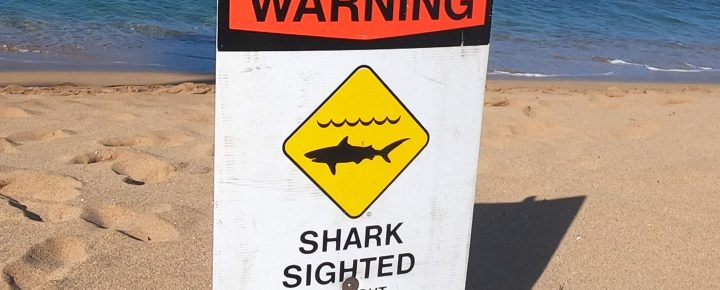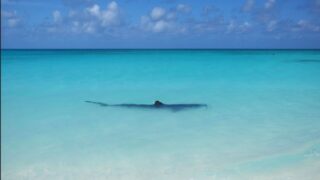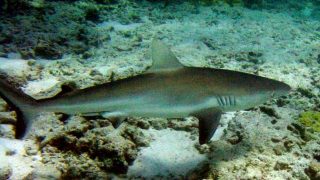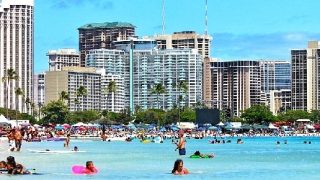There’s a warning sign we never want to see on our Hawaii beaches. And that’s one for shark sightings. Once a shark has been seen, a sign goes up, the beach closes for 24 hours, and if there has not been another sighting in that time period, the beach reopens.
There were two suspected shark attacks this week that closed beaches; the first ones of the year. They were at a popular surf spot on Oahu and at a Waikiki beach. An 11-year-old girl was bitten while she was swimming while another surfer escaped without injury.
The first incident unfolded on Saturday afternoon in the water off of Kualoa Ranch. Honolulu Emergency Medical Services dispatched first responders at 1:30 p.m. They had received notification via a 911 call that the girl’s left foot had been bitten. While frightening, it did not require her to be hospitalized. She was swimming near the shoreline when she came in contact with a small reef shark, which is often seen in Hawaii.
Kualoa Ranch, near where the shark bite occurred, is situated on the eastern coast of Honolulu, Oahu. It is a renowned 4,000-acre cattle ranch and nature reserve located between the Koolau Mountain Range and the Pacific Ocean. It has been used in movies and TV shows from Jurassic Park and Lost, to Godzilla.
The second attack took place near Waikiki at Kaimana Beach.
Just two days later, a surfer at Kaimana Beach, at the edge of Waikiki, had a very close call with an aggressive eight-foot tiger shark. This is one of our favorite go to beaches at Waikiki.
The surfer and the shark fought over the surfboard before the victim was able to get a hold of his board and paddle to safety. Miraculously, the surfer was not harmed, but the shark took a bite out of the board.
Shark warning signs were then posted along Kaimana Beach to alert beachgoers of the incident. Authorities confirmed, using video footage, that it was, in fact, an aggressive tiger shark.
International Shark Attack File’s recommendations on avoiding shark attacks in Hawaii.
Recent research indicates a likely correlation between bright and highly contrasting swimwear or dive gear and shark attacks. We have taken to wearing dark blue or black fins, mask, tank, and wetsuits when diving.
Skip the jewelry, too, and help avoid shark attacks.
Some experts argue that the color of your bathing suit may not be significant compared with steering clear of shiny objects including watches, which can reflect light similarly to fish scales. The International Shark Attack File suggests that individuals engaging in activities like swimming, snorkeling, surfing, and diving should conceal watches to reduce the risk of unprovoked shark encounters.
Recent research on shark attacks in Hawaii.
University of Florida scientists with researchers from the University of Hawaii conducted a 7-year study which shed light on the migration of mature female tiger sharks in Hawaii. The study highlighted among other things, differences in movements of male and female sharks. About 25% of mature females migrate from the remote French Frigate Shoals atoll to the main Hawaiian Islands late each summer and early fall, possibly to give birth. Researchers correlated the migration with an increase in tiger shark sightings and incidents during the fall, suggesting a link. While human-shark interactions were not the focus of the study, it nonetheless provided valuable insights into shark behavior, leading to a better understanding of shark behavior in Hawaii.
Confirmed Unprovoked Shark Attacks in Hawaii from 1828-Present.
Shark attacks in Hawaii are rare, but obviously do occur from time to time. Hawaii’s warm ocean water and abundant marine life provide an ideal habitat for sharks. The actual number of shark attacks in Hawaii, however, remains relatively low compared both with other places and to other ocean activity’ risks.
In most cases, sharks mistake a human for intended prey. Nonetheless, basic advice includes avoiding swimming alone, especially during early morning and late afternoon hours when sharks are most active, heed warning signs at beaches, and swimming where a lifeguard is present.
- Maui – 75 incidents
- Oahu – 42 incidents
- Kauai – 33 incidents
- Hawaii – 27 incidents
- Honolulu – 8 incidents
- Molokai – 2 incidents
- Open Ocean – 2 incidents
- Lanai – 1 incident
Get Breaking Hawaii Travel News







Wear a Sharkbanz around your ankle, the magnetic field disrupts the sharks sensory mechanism and deters them.